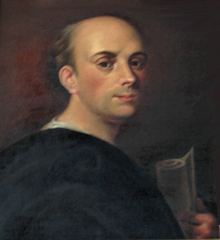Scipione Piattoli
Scipione Piattoli | |
|---|---|
 Portrait by Marcello Bacciarelli | |
| Born | 10 November 1749 |
| Died | 12 April 1809 (aged 69) Altenburg, Saxe-Gotha-Altenburg, Rhine Confederation |
| Nationality | Italian |
| Other names | Urban |
| Occupations |
|
| Known for | Co-drafting the Constitution of 3 May 1791 |
Scipione Piattoli (Italian pronunciation:
Piattoli was politically active in
Piattoli was an inspiration to Leo Tolstoy, who based the figure of Abbé Morio in War and Peace (1869) on him. He is also one of the figures immortalized in Jan Matejko's 1891 painting, Constitution of 3 May 1791. In his 1980 ten-page entry on Piattoli in the Polish Biographical Dictionary, historian Emanuel Rostworowski notes that, "despite two Italian monographs (by A.D. Ancon and G. Bozzolato)", Piattoli still awaits a definitive biography.
Early life
Scipione Piattoli was born in Florence on 10 November 1749 to a family of painters (father, Gaetano Piattoli; mother, Anna Bacherini Piattoli; brother, Giuseppe Piattoli).[1]
In 1763 he joined the
Piattoli arrived in the
Piattoli traveled through Europe in the retinue of the Lubomirski family, including Izabela, and as a tutor of young
Reformer and constitution drafter

Piattoli developed contacts with notable figures on the Polish political scene, initially from the group opposed to the royal faction.
Through his freemason contacts with Pierre Maurice Glayre, Piattoli won the confidence of Poland's King Stanisław August Poniatowski, becoming his agent in Paris and, by the end of 1789, his private secretary and librarian, although without any official title.[6][7] Acting as a sort of cultural aide, Piattoli, who had strong ties to the reformist and often anti-royal opposition, became an important link between the reformers—Ignacy Potocki in particular—and the king.[7][8] In the words of a Swedish diplomat, L. Engstrom, he was "like a tireless spring", constantly mediating between the two factions.[8]
Due to his association with the reformers, in conservative Rome he became infamous as a staunch supporter of revolutionary ideals and was accused of "democratism".[7] Vatican diplomats criticized the king for hiring such a "revolutionary", but the king defended Piattoli quite vividly.[7] In any case, many such claims were exaggerations or rumours spread by his political enemies: according to one such rumour, Piattoli was alleged to incite crowds in France to kill the king.[7][9] In reality, Piattoli supported the Monarchiens of the French Revolution's early stages, but more in the direction of peaceful transformation into a constitutional republic than the regicidal excesses.[7]
Between 1790 and 1792, Piattoli was sent on several sensitive
Later that month he became a founder of the
Final years
During the
In July 1794 he and several other activists were exiled from Leipzig, and Piattoli was soon arrested by the Austrian authorities.
After his release he returned to Dorothea's
In 1807 Scipione Piattoli returned to Courland.[18] There he finally settled, abandoned the priesthood, and married one of the ladies of the court.[3][6][18] In his final years in Courland he was involved with Courland's educational system, and hoped to pursue some scientific studies, a lifelong dream for which he never found enough time.[18] He died of a lung infection in Altenburg on 12 April 1809.[18] He was buried in a park in Löbichau.[18]
Remembrance
Piattoli was an inspiration to Leo Tolstoy, who based the figure of the Abbé Morio in War and Peace (1869) on him.[16][18] He is also one of the figures immortalized in Jan Matejko's 1891 painting, Constitution of 3 May 1791.[19] In his 1980 ten-page entry on Piattoli in the Polish Biographical Dictionary, historian Emanuel Rostworowski notes that, "despite two Italian monographs (by A.D. Ancon and G. Bozzolato)", Piattoli still awaits a definitive biography.[18]
See also
References
- ^ ISBN 83-04-00148-9, p. 818
- ISBN 978-83-89243-63-8. Retrieved 2 January 2012.
Niejasne jest jednak, czy w ogóle posiadał święcenia kapłańskie, z pewnością pędził jednak świecki tryb życia.
- ^ Encyklopedia WIEM. Accessed on 2 January 2012.
- ^ ISBN 83-04-00148-9, p. 819
- ISBN 978-0-520-09043-9. Retrieved 2 January 2012.
- ^ Państwowe Wydawnictwo Naukowe, 1975, p. 505.
- ^ ISBN 83-04-00148-9, p. 820
- ^ ISBN 83-04-00148-9, p. 821
- ISBN 978-0-19-925033-2. Retrieved 2 January 2012.
- ^ ISBN 83-04-00148-9, p. 822
- ^ ISBN 83-04-00148-9, p. 823
- ^ ISBN 978-1-881284-09-3. Retrieved 3 January 2012.
- ISBN 978-83-02-04615-5. Retrieved 2 January 2012.
- ^ ISBN 83-04-00148-9, p. 824
- ^ ISBN 83-04-00148-9, p. 825
- ^ ISBN 978-0-8014-7447-7. Retrieved 2 January 2012.
- ^ ISBN 83-04-00148-9, p. 826
- ^ ISBN 83-04-00148-9, p. 827
- ^ Państwowy Instytut Sztuki (Poland); Politechnika Warszawska. Zakład Architektury Polskiej; Stowarzyszenie Historyków Sztuki (1985). Biuletyn historii sztuki. p. 260. Retrieved 14 August 2011.
Further reading
- Bozzolato G., Polonia e Russia alla fine del XVIII secolo – Un avvanturerio ornarato: Scipione Piattoli, Padova 1964
External links
- (in Polish) Piattoli Scipione (1749-1809), based on the Polski Słownik Biograficzny entry (abridged). Muzeum Pałac w Wilanowie
